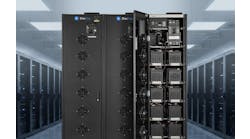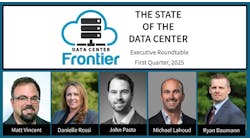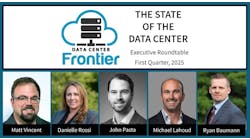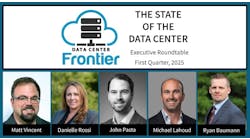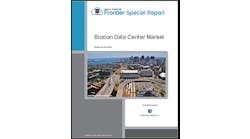The Data Center Frontier Executive Roundtable features insights from industry executives with lengthy experience in the data center industry.
Here’s a look at the Q1 2025 insights from Ryan Baumann, Vice President of Sales, Power Solutions for the Americas, Rehlko.
Ryan Baumann is Vice President of Sales, Power Solutions for the Americas at Rehlko (formerly Kohler Energy). As a power professional, Ryan has focused his efforts over the last 30 years with Rehlko to listen and grow from the various customers he’s engaged with. In his current role, Ryan is responsible for all Data Center projects, Telecommunications and Government customers and partners across the Americas.
During his tenure with Rehlko, Ryan has enjoyed all aspects of the power business. His early days were spent commissioning mission critical facilities across the globe, designing cutting edge control systems, and managing all aspects of sales, design, training, and production for large custom power projects. Ryan is committed to continuous improvement, providing best in class product, processes, and strategies to give our customers an experience unparalleled in the market.
Ryan is a graduate from the University of Wisconsin – Platteville, with a bachelor’s degree in electrical engineering. He and his wife, Jessica, enjoy travelling and exploring the country with their seven children.
Power Infrastructure & Energy Resilience in 2025
Data Center Frontier: As power constraints intensify across key data center markets, how are industry leaders addressing energy security, backup power solutions, and the integration of alternative energy sources such as hydrogen, natural gas, and nuclear?
Ryan Baumann, Rehlko: Industry leaders are taking bold steps to secure long-term energy availability by embracing innovative backup power solutions, forming strategic partnerships, and exploring alternative energy sources. To overcome the challenges ahead, collaboration is key—operators, utilities, OEMs, and technology providers must come together, share insights, and create customized solutions that keep energy both reliable and sustainable as the landscape evolves.
One of the most significant strategies is the growing use of alternative energy sources like hydrogen, natural gas, and even nuclear to ensure a steady supply of power. These options provide a more flexible, reliable backup to grid power, especially in markets with fluctuating energy demands or limited infrastructure. Emergency generator systems, when equipped with proper emissions treatment, can also support the grid through peak shaving or interruptible rate programs with utilities.
Hydrogen fuel cells, in particular, are becoming a game-changer for backup power. Offering zero-emission, scalable, and efficient solutions, hydrogen is helping data centers move toward their carbon-neutral goals while addressing energy reliability. When integrated into a microgrid, hydrogen fuel cells create a cohesive energy network that can isolate from the main grid during power outages, ensuring continuous energy security for critical infrastructure like data centers.
Additionally, natural gas Central Utility Plants (CUPs) are emerging as a key bridging power source, helping large data centers in grid-constrained regions maintain operations until permanent utility power is available. Smart energy solutions, including customized paralleling systems, allow emergency assets to be grid-intertied, enabling utilities and communities to share power burdens during peak periods.
By embracing these innovative solutions and fostering collaboration, the industry not only ensures reliable power for today’s data centers but also paves the way for a more sustainable and resilient energy future.
The Cooling Imperative: Managing High-Density AI Workloads
Data Center Frontier: With the rapid rise of AI-driven workloads pushing power densities beyond traditional limits, what new cooling technologies and efficiency strategies are being deployed to maintain operational stability and sustainability?
Ryan Baumann, Rehlko: AI workloads put a huge strain on power infrastructure, making backup power essential for data centers to avoid downtime during grid disruptions or peak demand periods. Backup generators are a go-to solution because they’re dependable and built to handle high-power loads when it matters most. Diesel-powered systems, in particular, deliver fast, high-density power, ensuring data centers stay up and running—even under the intense demands of AI applications.
To boost generator efficiency while also moving toward cleaner energy solutions, many data centers are adopting smarter maintenance strategies. We introduced our Conscious Care program to cut fuel use and lower costs while keeping operations running smoothly. By letting operators run emergency generators at no load and extending the load interval to every four months, the program helps reduce fuel consumption, air and noise pollution, greenhouse gas emissions, and overall energy expenses.
By implementing more efficient maintenance strategies, data centers can strengthen their power reliability and operational stability while making real progress toward sustainability and efficiency.
Site Selection & Market Evolution in a Constrained Environment
Data Center Frontier: Given ongoing challenges in land acquisition, power availability, and local regulatory hurdles, how are data center operators refining their site selection strategies in Q1 2025? Which North American markets are emerging as the next hotspots for development?
Ryan Baumann, Rehlko: While data center operators focus on securing locations with diverse power sources, they must also consider power reliability—because without consistent, high-quality power, data centers simply can’t function. Many power grids, especially in the U.S. and Europe, are aging, leading to higher failure rates, voltage fluctuations, and more frequent outages—all major risks for data centers. Additionally, the demand for electricity is surging due to the rapid growth of hyperscale data centers and AI-driven workloads. Regions like Texas and Northern Virginia are already feeling the strain, raising concerns about long-term power availability.
Regions that have not traditionally experienced data center growth, like my home state of Wisconsin, are seeing increased interest from data center companies. Communities are actively working to partner with developers and end users to support the necessary expansion in this sector. It is vital for OEMs, like Rehlko, to collaborate with communities alongside our end-user clients to raise awareness about the critical role data centers play in our daily lives and economy. The resilience, services, and innovations we rely on—often without realizing it—are largely made possible by data centers.
To stay ahead of the challenges surrounding power reliability, many data centers rely on uninterruptible power supplies (UPS) and diesel backup generators. UPS systems provide instant backup power to prevent disruptions, while diesel generators offer long-term reliability—keeping operations running smoothly no matter what happens. Together, they create a layered power resilience strategy, ensuring redundancy, stability, and the ability to meet growing energy demands.
We have partnered with iMasons, a forward-thinking organization that focuses not only on the climate impact of data center growth but also on the social acceptance and integration of these facilities. As we move into the future, improving efficiency and educating the public about the essential functions of data centers is imperative. Their impact extends far beyond social media and autonomous vehicles—they are the lifeblood of hospitals, clinics, medical research, and virtually every aspect of modern life.
The Changing Economics of Data Center Development
Data Center Frontier: With rising construction costs, supply chain challenges, and shifting enterprise demands, how are data center providers, energy specialists, and real estate firms adapting their business models to sustain growth and profitability in 2025?
Ryan Baumann, Rehlko: One major shift we're seeing is the move toward modular and scalable infrastructure, which gives data center operators the flexibility to expand while keeping costs in check. Different modules can be easily swapped or upgraded as needed, and the approach also streamlines the manufacturing process, allowing components to be produced in parallel. This helps reduce lead times and alleviate supply chain pressures.
Energy reliability remains a top priority, which is why data centers are doubling down on backup power solutions that incorporate cleaner fuel alternatives like Hydrotreated Vegetable Oil (HVO) and hydrogen. These options not only keep operations running smoothly but also support sustainability goals as the industry pushes toward carbon neutrality.
The data center providers that thrive will be the ones that stay agile, innovate with energy-efficient solutions, and invest in resilient, sustainable power strategies—all while keeping costs under control.

Matt Vincent
A B2B technology journalist and editor with more than two decades of experience, Matt Vincent is Editor in Chief of Data Center Frontier.

